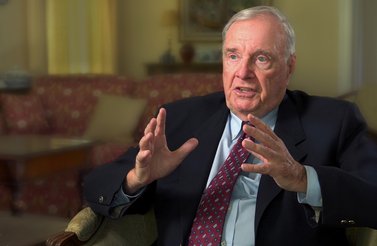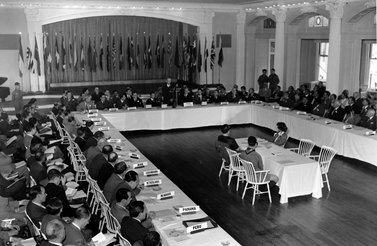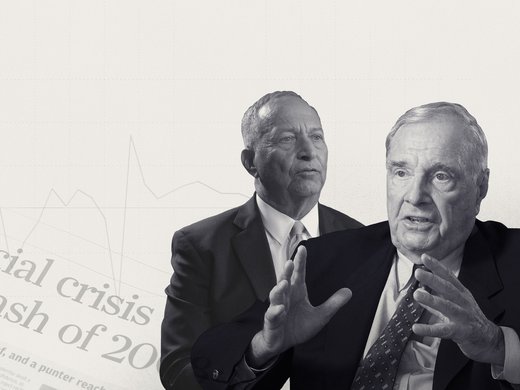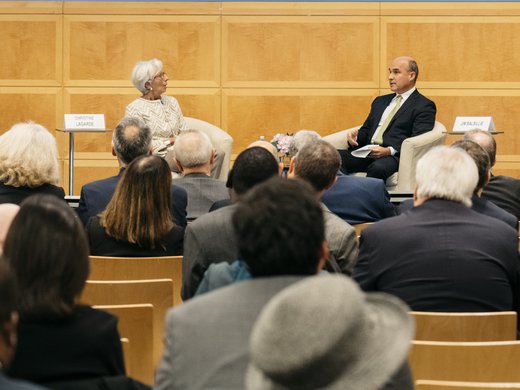Throughout history, international orders have been constructed, contested, upended and dismantled. The current international order goes back to the end of World War II. The period before — between the two world wars and including the Great Depression that resulted after the 1929 stock market crash — had already proven that a multilateral scheme based on a gold exchange standard was not optimal (or even possible, given that gold reserves were primarily held in the central banks of a few states), and, ultimately, it was unfit to respond to a global financial crisis.
In 1944, the conference held at the Mount Washington Hotel in Bretton Woods, New Hampshire, paved the way for a new world economic order in the aftermath of World War II. The conference laid out the architecture of the monetary system to be put in place, pegged to the US dollar and a basket of convertible currencies, and a system of international trade, which had a new institution, the International Monetary Fund (IMF), as the guardian of the agreements.
Given the new balance of powers among allies, and the growing role for the United States, British economist John Maynard Keynes’ views about the establishment of a new global reserve currency (the “bancor”) were not accepted. Rather, Harry D. White’s idea to return to a gold exchange standard based on a central role for the US dollar as the main international reserve currency was adopted.
As the Bretton Woods agreements were a landmark in the definition of the new architecture of the international monetary system, we should not forget how much the world had changed with respect to the previous schemes, which became unfit for the purpose.
Policy makers must recognize that new orders have often followed dark epochs. Moreover, many existing structures remain relevant, while others require renovation. The question is how can old and new institutions fit together and become the cornerstone for future construction?
The task is not to rebuild an international order from the ground up: many prevailing institutional structures are sound. But do they all meet twenty-first-century needs? Past examples, such as the interwar period, demonstrate how instability can have a lasting impact on the international monetary system.
The Role of the Dollar and the Quest for a New Bretton Woods
After two decades, the system established at the Bretton Woods conference proved its inability to adjust economic and commercial imbalances between its member states. Starting from the beginning of the 1960s, the system began to be theoretically challenged by non-Keynesian economists. At the beginning of the 1970s, with the US announcement to suspend the convertibility of the dollar into gold, the exchange system based on the gold exchange standard established at Bretton Woods ended.
However, this event did not compromise the role of the dollar as an international currency with its triple function as a store of value, unit of account and medium of exchange. Despite an international monetary system largely turned anarchic — not guided by clear rules — the dollar maintains and reinforces a dominant role under the international monetary system, giving the United States the so-called “exorbitant privilege.” This role has never been questioned by other emerging powers, especially the more economically integrated Asian emerging countries, nor by the creation of the euro.
Policy makers must recognize that new orders have often followed dark epochs. Moreover, many existing structures remain relevant, while others require renovation.
In the wake of the 2008 financial crisis and now the COVID-19 pandemic, a debate about the adequacy of the international monetary system has gained attention, as trade imbalances (in particular between China and the United States) are leading to permanent tensions in the monetary system, which could eventually put the credibility of money as we know it at stake. The US dollar remains — as the 2008 crisis demonstrated — the main “safe asset” for international relations, and around three-quarters of international currency reserves by central banks are denominated in US dollars.
However, there are at least three factors that reintroduce the debate on the role of the dollar and on the necessity of a new international agreement that lays the foundations for a new monetary order and shared rules on international trade:
- the emerging fragility of economic hyperglobalization and the research for new rules to govern international trade;
- technology and the digital divide, which is affecting trade and payment systems worldwide, including the idea of digital currencies that are out of the control of any central bank; and
- the changed geopolitical and geo-economic framework, which has reintroduced, in this new context, the strategic and political use of the dollar, defined as “dollar weaponization.”
In a post-COVID-19 world, 75 years after the debate between Keynes and White about the eventual need for a global reserve currency not controlled by a state, redesigning a new economic world order able to ensure cooperation between nations will be key.
Recent Developments and the First Debate for a Renewed Bretton Woods
Since the accession of China to the World Trade Organization in 2001, there has been talk about a “renewed” or “second” Bretton Woods, with some of the principal Asian currencies, in particular, the Chinese renminbi, in addition to Latin America’s currencies, pegged to the dollar along with controls on international capital flows between these countries and the United States.
The story of this second Bretton Woods, and the global imbalances associated with it, is instructive. Rapid economic growth in China coincided with its accelerated integration in the global economy. Its double-digit growth in trade with foreign countries, compared with the overall growth in global trade, generated increased and persistent trade balances and current account surpluses. In the three years preceding the 2008 financial crisis, the Chinese current account surplus was, on average, nine percent of its GDP.
Until 2005, China had, for many years, avoided adjusting its trade imbalances by maintaining a fixed exchange rate with the dollar and controls on financial capital outflows, and also by accumulating official foreign reserves, which, in 2011, accounted for 25 percent of registered central banks’ global foreign reserves.
China’s purchase of public debt and other financial assets issued from countries with trade deficits, in particular the United States, enabled these countries to maintain high internal liquidity, allowing them to sustain their internal consumption and investment demand. In addition, these purchases allowed China to control its excess liquidity and, as a result, to control its inflation pressures.
In summary, the two sides of the Pacific neutralized the classic monetary adjustment mechanism of fixed exchange rate imbalances, namely the adjustment of real exchange rates through shifting domestic prices. The American expansionary monetary policy, which at the turn of the century had supported the new economy and real estate market speculative bubbles (and had financed the excess domestic demand), has been different from the People’s Bank of China’s (PBOC’s) policy of exchange control and trade surplus management. However, even this second Bretton Woods, which rather than a formal agreement has been a tacit way of doing business with an understanding of the benefits for both parties (the United States and China), couldn’t survive the 2008 financial crisis. Already in 2005, under US pressure, China abandoned pegging its exchange rate to the dollar; in just three years (2005–2008), the renminbi appreciated by about 18 percent.
In the midst of the 2008 financial crisis, China restored the policy of pegging its currency to the dollar, but ultimately abandoned it again. The idea that has consolidated in China is that the dollar standard is no longer able to ensure monetary stability in the relations between America and Asia and the American financial market will be unable to maintain its dominant position in the future. The increased exchange rate flexibility that China has decided to adopt responds to the goal of orienting production toward its domestic market. This goal is pursued because the foreign market, compared to a tremendously increased production capacity and to an accumulation of private savings with a high inflationist potential, is too fragile.
This means that China, in the medium term, will no longer be interested in financing the American deficit. This change will, however, take some time, since avoiding a rapid depreciation of the dollar that could, in turn, devalue China’s dollar-denominated assets is a concern. In addition, Asia still lacks a financial market that is sufficiently sophisticated to assure proper investment options for its savings.
At the Group of Twenty summit in London in 2009, leaders planned to discuss how the major world economies were managing the financial crisis that originated in the United States. Prior to the meeting, on March 23, the journal of the Bank for International Settlements published a paper by Zhou Xiaochuan, at that time the governor of the PBOC. In the paper, the Zhou reiterated the problem of the impossibility of dealing with global macroeconomic imbalances and assuring financial stability without confronting the unsolved issue of the international monetary system, namely the absence of an international reserve currency pegged to a stable value. He reintroduced Robert Triffin’s arguments on the flaws of a system where a national currency serves, de facto, as a global reserve currency and declared himself in favour of a supranational international reserve currency, explicitly recalling the bancor, the international currency unit, proposed in 1944 at Bretton Woods by Keynes.
Zhou’s proposal was to immediately reconsider the role of special drawing rights (SDR), created by the IMF in 1969, and intended to be an asset held in foreign exchange reserves under the Bretton Woods system of fixed exchange rates. In particular, fostering the use of the SDR as a medium of exchange between the commercial and financial transactions of governments and financial institutions was proposed. Moreover, part of every country’s official reserves should have been managed and held by the IMF so that market stability would be strengthened.
In the past 10 years, there has been a separation between the role of the dollar in the international monetary system and the economic global power of its issuer country. Today, the United States produces about 15 percent of world GDP and represents 10 percent of global trade. However, one-third of the countries in the international system adopt a currency explicitly pegged to the dollar, 70 percent of global GDP uses the dollar as a benchmark currency, 50 percent of global invoices and two-thirds of foreign official reserves and global external debts are dollar-denominated.
Since the majority of international trade is invoiced in dollars, it is logical to ensure oneself with dollar-denominated financial assets and retain large official reserves in dollars to be isolated from the impact of dollar fluctuations as a result of American economic cycles and monetary policies. Emerging countries are, as a result, forced to use their monetary policies to stabilize capital flows. The conclusion of this analysis is that the US dollar, which remains as important as when the Bretton Woods system collapsed in 1971 (despite emerging countries now representing 60 percent of global GDP), would still remain dominant even if the US relative economic power further declined.
On July 17 and 18, 2019, at the meeting of Group of Seven (G7) finance ministers and central bank governors, in Chantilly, France, Facebook’s plan to launch the Libra, a stable coin presented as a simple means of payment but pegged to a basket of stable currencies was discussed with ill-concealed — and not unwarranted — concern. This specific project did not pose any danger (its probability of success was low), but it was immediately understood as representing the first real potential challenge launched at what remains of the international monetary system established at Bretton Woods (and, what is more, the challenge would come from a pool of private companies).
This new cryptocurrency project with global ambitions was presented as merely a cross-border means of payment directed at drastically cutting the cost and time of transnational payments and aiming to include large sectors of the population, especially in developing countries, that are effectively excluded from payment methods based on banking systems. It paved the way for a larger challenge.
The only efficiency gains, given by the transition to digital currencies, do not appear huge today if we consider that new technologies have already activated widespread payment systems tied to private platforms without the need to adopt a cryptocurrency as a unit of account or a store of value.
Also, the current interbank transfer systems, for example, the Euro-American Society for Worldwide Interbank Financial Telecommunication (SWIFT) and the European Central Bank system TARGET Instant Payment Settlement (TIPS), are experimenting with new systems of instantaneous transfers. However, the Libra project was a challenge for central banks to adopt digital currencies and, most importantly, it also showed that economies and technologies were mature enough for the adoption of a global currency based on the Keynesian bancor model.
One month later, Mark Carney, the governor of the Bank of England and one of the participants at the G7 meeting, spoke in front of an audience of bankers and economists at the US Federal Reserve’s annual meeting in Jackson Hole, Wyoming. He suggested that the world dependence on the US dollar was no longer sustainable and invited the IMF to take the lead on designing a new international monetary and financial system based on multiple currencies.
Carney’s analysis is based on the finding that it is not true that a flexible exchange rate regime is the solution that will enable countries to absorb global shocks and maintain stable production levels and domestic prices through a flexible monetary policy. The argument is that the increased global economic and production integration, as well as the development of international value chains, has led to increased synchronization between price movements and production in the various countries.
The result is that global growth is strongly affected by the impact of economic events and American monetary policies on the dollar, leaving countries exposed to the volatility of the US currency and to global risks.
This derives from the increased rigidity of international prices denominated in dollars compared to the fluctuations of the other currencies, due to the fact that the US dollar represents the currency used in half of the international trade invoices — about five times the US share of global imports and three times its share of global exports. The consequence is that the depreciation of a currency against the dollar discourages imports, making goods and services produced abroad more expensive in terms of domestic currency. However, this has no effect on the prices of exports denominated in dollars and, therefore, delays the adjustment of the exported quantities, causing only enhanced profits in terms of the domestic currency for exporters.
The result is that global growth is strongly affected by the impact of economic events and American monetary policies on the dollar, leaving countries exposed to the volatility of the US currency and to global risks. Carney’s conclusion, like that of other economists, is once more that the dominant role of the dollar in the monetary system is a source of instability and, as a result, a multipolar system transition is needed. This multipolar system could be based either on several international currencies or a single global currency, which could take the form of a global electronic currency.
The alternative could be a future conflict between the dollar and the renminbi, the use of which is increasing in global trade. These analyses are not much different from those made by the PBOC governor 10 years earlier, which, in turn, reintroduced the debate made almost 50 years earlier.
However, the transition to a new international reserve currency is a complex issue that follows not only an economic decline of the issuer country, but also the diffusion of the new currency as a medium of exchange, which, therefore, must be efficient and convenient in the international payments. Its adoption as a unit of account and store of value is a consequence. It follows that technology today can play a key role in overtaking the network externalities that hinder the transition to a new international monetary system similar to that proposed by Keynes. Technology can do this by, using Carney’s definition, creating an “hegemonic synthetic currency” through a network of central banks’ digital currencies. China has already announced that the PBOC is planning to issue an official digital currency.
This decision could probably generate a first global challenge, although it seems unlikely that a digital renminbi can be a competitive global currency. Those who argue against a new global currency recall data showing evidence about the persistent dominant role of the dollar, demonstrating that the strength of the dollar as a safe asset does not simply result from the current network effect. As recently claimed by Henry M. Paulson Jr., Secretary of the Treasury during the George Bush administration, “the privilege conferred on the US dollar as the global reserve currency was hardly preordained.”
A New Economic Order after Pandemic Disruption?
The global economy after COVID-19 faces unprecedented challenges: a deep recession that hit all economies (advanced and emerging economies as well as developing economies), and an unprecedented explosion of sovereign and private debts all over the world.
Considering the three global trends that existed before COVID-19 crisis — the retreat from hyperglobalization; the relationship between market and government, with a growing role for the latter, evident also in Europe; and a declining growth rate — the pandemic will probably not be a game changer but rather a game accelerator.
China, France, Germany, Italy, Japan, the United Kingdom and the United States, countries with among the highest infection rates, represent almost 60 percent of world GDP, 65 percent of world manufacturing product and more than 50 percent of world manufacturing exports. Each of these countries is an important supplier of industrial inputs to each other and to third countries and they are at the heart of a myriad of international supply chains.
As a result, emerging from the crisis would require the maximum attention to save the international reciprocal interactions, even if the pandemic has also highlighted the vulnerability of the current hyperglobalization phase and has offered arguments to pre-existing anti-globalization sentiments. In view of the balance of the economic order, it would be a risky reaction by countries that follow the demand to reduce the global connections between economies, under the psychological pressure of pandemics, in response to political arguments for achieving national self-sufficiency in the provision of essential goods.
In particular, the danger is the decoupling of — more generally seen as the conflict between — the West and China. The fact that we freely speak about it suggests that, for some analysts, the so-called trade war between the United States and China is only the starting point of a technological competition that includes not only the configuration of the global value chains, but also geostrategic matters such as security, the unity and interconnection of information and communications technology networks, and the financial and international payment infrastructures.
Behind the current idea of decoupling there is essentially the fear of China’s technological growth in all aspects, which could translate in geopolitical hegemony. This view may lead to a world divided into two technological blocks, where innovations would not freely expand globally, but only within two competing areas, one controlled by the United States and the other one by China.
Nevertheless, such a decoupled world is still highly unlikely, both because China is not yet fully technologically independent, and because of the difficulty of untangling in a non-destructive way the infinite number of connections that bind the world. Furthermore, if a trend toward deglobalization prevails, the world economy would face a long period of low growth, which would clash with the explosion of sovereign and private debts left by COVID-19. The outcome would be a serious risk of a global financial crisis.
Attention must be paid in order to avoid strong action to combat the COVID-19 pandemic contributing to a viewpoint that identifies a globalized world as the root cause of dangers that can only be challenged by closing down borders. During the 2008 financial crisis, China and the United States adopted a cooperative response, with a great fiscal stimulus in China and unconventional monetary policies in the United States. China and the United States were linked by the global macroeconomic imbalance that consisted of the gigantic Chinese trade surplus and the American trade deficit.
China thus accumulated dollar reserves and at the same time tied itself to the dollar system and to the maintenance of its value, allowing the United States to procrastinate its internal rebalancing. As noted above, some analysts named the implicit agreement to maintain this global imbalance as a sort of second Bretton Woods system.
But many things have changed since then. China has not only grown in weight as a global economy but has massively rebalanced its economy. There are two consequences of this overall rebalancing. The first is that China no longer has an excessive trade surplus (1.5 percent of GDP). The second is that China has climbed the ladder of the value added along the international supply chains and no longer plays the role of an emerging country. Therefore, the unstable equilibrium developed between the end of the last century and the first decades of the new millennium no longer holds, resulting in a substantial geo-economic and geopolitical change.
Therefore, in order to avoid turning competition into conflict, a new multilateral cooperative agreement is needed to design the governance of the global economy of the future, taking note of the new geo-economic and geopolitical global weight, but also keeping in mind that the total population of United States, Europe, China and Russia is less than half of the world’s population
In the post-COVID-19 world, a “new Bretton Woods” agreement is an alternative to protectionism, nationalism and the disruption of international trade and investment channels that have contributed so far to the growth of global well-being.
A New Financial and Economic Perspective to Restore Confidence after COVID-19
As we argued in a blog for the Transatlantic Leadership Network, the COVID-19 pandemic put up an obstacle to globalization — a seemingly unstoppable process that led to increasing production and financial hyperconnectivity and also brought the fast movement of not only goods and persons, but also, increasingly, of ideas, knowledge, uncertainties and fears. Today, however, globalization as a long-lasting process is challenged.
The spread and length of the pandemic, as well as the subsequent interruption of the production and consumption chains that the measures introduced to halt it have caused, will determine the economic consequences of COVID-19. The speed with which the economic policies of all the major countries are able to anticipate the negative expectations by announcing, and quickly implementing, expansive fiscal measures, such as monetary policies, will also play a role.
This uncharted territory also put into question the recovery capability of the economy itself. A lack of clear expectations may determine economic players’ inability to respond in the best way possible according to the available information. In recent years, the excess of information led to less rational interpretation by economic and social players, and hyperconnectivity and the rapid circulation of any kind of information may have transformed local uncertainties into global systemic crises.
The global financial and trade architecture, which, since the Bretton Woods conference has ensured the stability of the financial order put in place after World War II, and somehow (with notable changes and adaptations) survived until today, is now pushed to the limit.
It must not be forgotten that one of the positive effects of an interconnected world is the production of global common goods, such as the fight against climate change and pollution, the diffusion of knowledge and education, scientific progress, human rights, medical advancements and the global fight against endemic illnesses.
A coordinated effort in the reconstruction of the monetary system worldwide could be the way to avoid a very costly “financial war.” It is time to rethink a new scheme for the years to come, which entails a new Bretton Woods initiative, jointly promoted by all main economies, including the new emerging ones.





